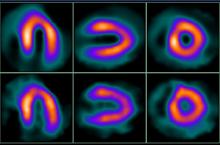
July 29, 2009 – The Society of Nuclear Medicine (SNM) and a coalition of eight other organizations have issued a white paper urging Congress to take steps to maintain adequate supplies of molybdenum-99 (Mo-99), a radioactive substance that is the basis for a common medical isotope used in more than 80 percent of all nuclear medicine procedures.
The coalition jointly issued the paper to ensure that patient care is not compromised by a worldwide shortage of Mo-99 and measures to curtail the use of high-enriched uranium (HEU) in radionuclide production as a non-proliferation strategy. In response, U.S. Rep. Edward Markey (D-Mass.) introduced legislation (H.R. 3276) reflecting many of the coalition's concerns. The coalition has endorsed the legislation.
In addition to SNM, the coalition includes the American Association of Physicists in Medicine (AAPM), American College of Radiology (ACR), American Nuclear Society (ANS), American Society of Nuclear Cardiology (ASNC), American Society for Radiation Oncology (ASTRO), Council on Radionuclides and Radiopharmaceuticals (CORAR), Health Physics Society (HPS) and Nuclear Energy Institute (NEI).
"Recent closures of nuclear facilities abroad are putting a severe strain on our ability to meet demand for this critical medical isotope," said Michael Graham, M.D., Ph.D., president of SNM. "Congress should take steps to boost production domestically and to ensure that the transition away from using highly enriched uranium in medical isotope production does not further strain supplies. We applaud Congress for taking up this issue and urge the government to act without delay."
Mo-99 decays into technetium-99m (Tc-99m) – a medical isotope used in approximately 16 million nuclear diagnostic imaging procedures annually in the United States. These noninvasive procedures are essential for accurately diagnosing and treating patients with potentially life-threatening conditions such as cancer, heart disease and neurologic conditions.
Currently, more than 90 percent of Mo-99 is produced in aging nuclear reactors located in Canada, the Netherlands, Belgium, France and South Africa. Concerns about medical isotope supplies have mounted in recent years as scheduled and unplanned shutdowns of overseas reactors have interrupted production. Most recently, the National Research Universal reactor in Ontario, Canada, which supplies about 40 percent of the world's Mo-99, was shut down until later this year because of a heavy water leak following a power outage.
Further complicating the situation are recent recommendations to curtail the use of HEU in radionuclide production because of potential security concerns. However, the conversion to the alternative low-enriched uranium (LEU) to produce medical isotopes is still years away. Before such a transition can take place, large-scale commercial facilities must be planned, converted and demonstrate efficacy.
To address these concerns, the coalition's white paper recommends that the government explore a public-private partnership to speed the availability of Mo-99 and ensure continued diagnostic imaging for patients. It is imperative that domestic sources of Mo-99 be developed to guarantee a reliable supply.
The paper identifies two potential domestic sources of Mo-99 as the most viable: the University of Missouri Research Reactor Center (MURR) in Columbia, Mo., and the collaborative effort between the companies Babcock & Wilcox (B&W) and Covidien to build a reactor running strictly on LEU. MURR could meet approximately 50 percent of the U.S. demand for Mo-99 with little change, the paper notes, and it could also help fill gaps in supplies during planned shutdowns of other reactors. B&W and Covidien estimate that a new reactor technology could be operational in about five years and supply half of the U.S. demand for Mo-99. Together, these two sources could eventually meet 100 percent of the U.S. demand for Mo-99. The coalition urges the government to speed approvals for these facilities and support the Markey bill, which provides federal funding for the projects.
The organizations stress that any requirement to transition from HEU to LEU in the production of medical isotopes must ensure that supplies of Mo-99 are sufficient and that patient needs are not compromised. Adequate time must be available for research and development to guarantee that the technology and equipment are robust and reliable.
For more information: visit www.snm.org
?


 November 12, 2025
November 12, 2025 









